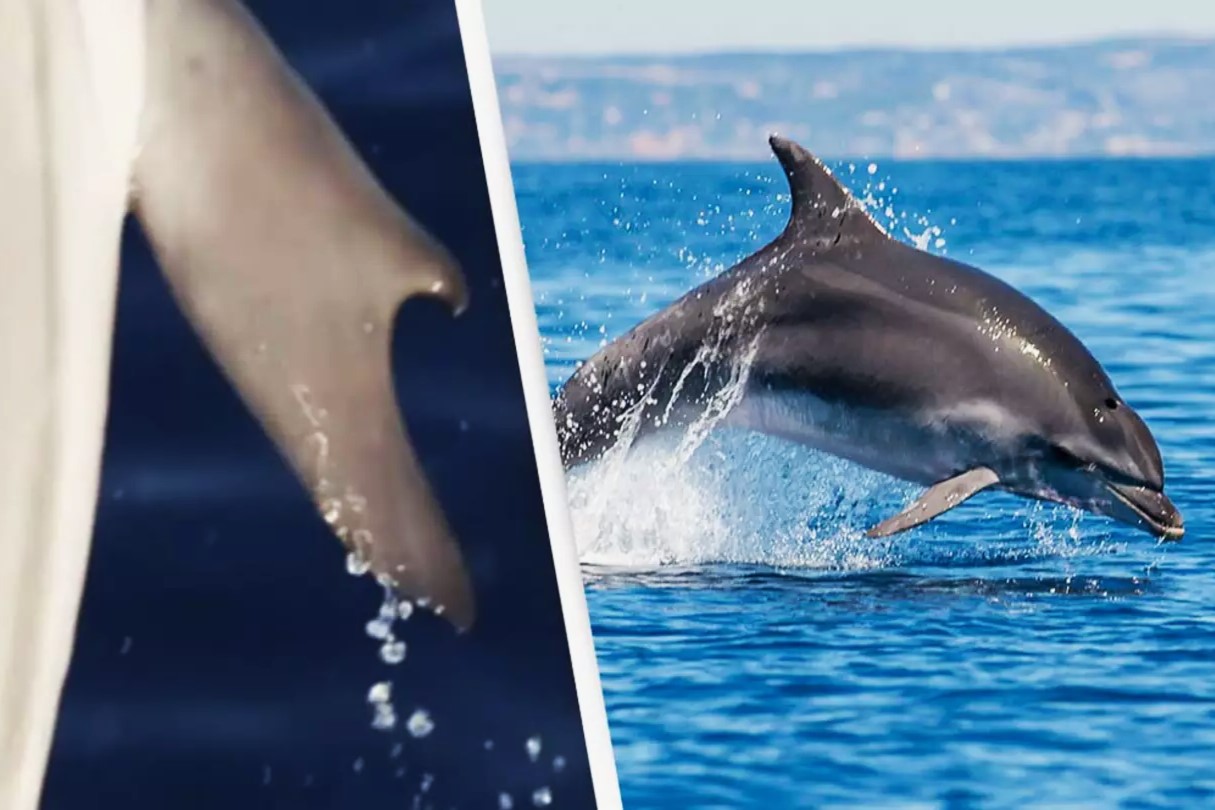
Did you know dolphins have thumbs? These intelligent marine mammals never cease to amaze us with their unique traits. Dolphins are known for their playful behavior, but their anatomy holds some surprising secrets. Thumbs in dolphins might sound like something out of a sci-fi movie, but it's a fascinating reality. This feature gives them an edge in their underwater acrobatics and social interactions. Imagine a dolphin waving at you with a thumb-like fin! Intrigued yet? Dive into these 35 incredible facts about dolphins and discover how these thumb-like structures impact their lives. Get ready to see dolphins in a whole new light!
Key Takeaways:
- Dolphins have thumb-like bones in their fins, aiding in their intelligence, playful behavior, and hunting techniques. These unique structures contribute to their agility and social interactions.
- The thumb-like bones in dolphins' fins are a result of evolutionary adaptation, providing them with better control and agility in their aquatic environment. These structures play a role in their communication, parenting, and hunting behaviors.
Dolphins: The Ocean's Intelligent Mammals
Dolphins are fascinating creatures known for their intelligence, playful behavior, and unique physical features. One of the most intriguing aspects of dolphins is their thumb-like appendages. Let's dive into some amazing facts about these marine mammals.
Unique Anatomy of Dolphins
Dolphins have several anatomical features that set them apart from other marine animals. Their thumb-like structures are particularly interesting.
- Dolphins possess pectoral fins that contain bones similar to human hands. These bones include structures resembling thumbs.
- The thumb-like bones in dolphins' fins are called phalanges. They help dolphins maneuver through water with precision.
- Unlike humans, dolphins' thumb-like structures are not visible externally. They are embedded within the fins.
- These thumb-like bones are a result of evolutionary adaptation. They provide dolphins with better control and agility in their aquatic environment.
Intelligence and Social Behavior
Dolphins are renowned for their high intelligence and complex social structures. Their thumb-like appendages play a role in their interactions.
- Dolphins use their pectoral fins to communicate with each other. They touch fins as a form of social bonding.
- The thumb-like bones in their fins allow for delicate movements, enabling dolphins to perform intricate tasks.
- Dolphins are known to use tools, such as sponges, to protect their snouts while foraging. Their thumb-like structures aid in manipulating these tools.
- These marine mammals exhibit problem-solving skills and can learn new behaviors through observation and imitation.
Playful Nature and Physical Abilities
Dolphins are playful creatures that engage in various activities for fun. Their unique anatomy contributes to their playful behavior.
- Dolphins often engage in playful activities like leaping out of the water and riding waves. Their thumb-like bones help them maintain balance.
- They are known to play with objects, such as seaweed and small fish. Their pectoral fins, with thumb-like structures, assist in handling these objects.
- Dolphins can swim at speeds of up to 25 miles per hour. Their thumb-like bones provide the necessary agility for such swift movements.
- These marine mammals are capable of performing acrobatic stunts. Their unique fin structure allows for precise control during these maneuvers.
Communication and Echolocation
Dolphins have sophisticated communication systems and use echolocation to navigate their environment. Their thumb-like appendages play a role in these processes.
- Dolphins produce a variety of sounds, including clicks and whistles, to communicate. Their pectoral fins help them express emotions through body language.
- They use echolocation to locate prey and navigate. The thumb-like bones in their fins assist in making quick directional changes.
- Dolphins can recognize themselves in mirrors, indicating a high level of self-awareness. Their thumb-like structures contribute to their ability to interact with their reflection.
- These marine mammals can understand complex commands and even learn sign language. Their pectoral fins, with thumb-like bones, aid in performing learned behaviors.
Reproduction and Parenting
Dolphins have unique reproductive and parenting behaviors. Their thumb-like appendages play a role in caring for their young.
- Female dolphins give birth to live young, called calves. They use their pectoral fins to guide and support their newborns.
- The thumb-like bones in their fins help mothers gently push their calves to the surface for their first breath.
- Dolphins exhibit strong maternal instincts. They use their pectoral fins to keep their calves close and protect them from predators.
- These marine mammals engage in alloparenting, where other members of the pod help care for the young. Their thumb-like structures facilitate these interactions.
Diet and Hunting Techniques
Dolphins have diverse diets and employ various hunting techniques. Their unique anatomy aids in capturing prey.
- Dolphins primarily feed on fish and squid. Their pectoral fins, with thumb-like bones, help them herd and capture prey.
- They use a technique called fish whacking, where they stun fish with their fins before eating them.
- Dolphins often hunt in groups, using coordinated strategies to encircle and trap prey. Their thumb-like structures enable precise movements during these hunts.
- These marine mammals can dive to depths of over 1,000 feet in search of food. Their unique fin anatomy provides the necessary control for deep dives.
Conservation and Threats
Dolphins face various threats in their natural habitat. Understanding their anatomy and behavior is crucial for their conservation.
- Dolphins are threatened by pollution, which can harm their health and habitat. Their thumb-like structures are sensitive to changes in water quality.
- They are also at risk from fishing nets and other human activities. Their unique anatomy makes them vulnerable to entanglement.
- Conservation efforts focus on protecting dolphin habitats and reducing human impact. Understanding their thumb-like bones helps in developing effective strategies.
- Dolphins are often kept in captivity for entertainment. Their complex social and physical needs make captivity challenging for their well-being.
Fascinating Dolphin Species
There are several species of dolphins, each with unique characteristics. Their thumb-like appendages are a common feature among them.
- The bottlenose dolphin is the most well-known species. They are highly intelligent and have prominent thumb-like bones in their fins.
- The spinner dolphin is known for its acrobatic spins. Their unique fin structure allows for these impressive displays.
- The common dolphin is recognized for its distinctive hourglass pattern. They have thumb-like bones that aid in their swift movements.
- The Amazon river dolphin is a freshwater species with a pinkish hue. Their pectoral fins, with thumb-like structures, help them navigate murky waters.
- The orca, or killer whale, is the largest member of the dolphin family. They have robust thumb-like bones that support their powerful movements.
Interesting Dolphin Behaviors
Dolphins exhibit a range of behaviors that showcase their intelligence and adaptability. Their thumb-like appendages play a role in these activities.
- Dolphins are known to surf on waves created by boats. Their unique fin structure helps them maintain balance during this activity.
- They engage in cooperative hunting, where they work together to catch prey. Their thumb-like bones enable precise coordination during these hunts.
Dolphins: Nature's Marvels
Dolphins, with their unique anatomy and intelligent behavior, continue to amaze us. Their thumb-like structures aren't just fascinating; they highlight the complexity of marine life. These creatures communicate using a variety of sounds, showing a level of social interaction that rivals many land animals. Their playful nature and problem-solving skills make them a favorite among researchers and enthusiasts alike. Understanding dolphins better not only enriches our knowledge of the ocean but also underscores the importance of marine conservation. Protecting these incredible animals ensures that future generations can appreciate their wonders. So next time you see a dolphin, remember, there's more to them than meets the eye. They're not just swimming; they're showcasing the beauty and intelligence of the natural world.
Frequently Asked Questions
Was this page helpful?
Our commitment to delivering trustworthy and engaging content is at the heart of what we do. Each fact on our site is contributed by real users like you, bringing a wealth of diverse insights and information. To ensure the highest standards of accuracy and reliability, our dedicated editors meticulously review each submission. This process guarantees that the facts we share are not only fascinating but also credible. Trust in our commitment to quality and authenticity as you explore and learn with us.


